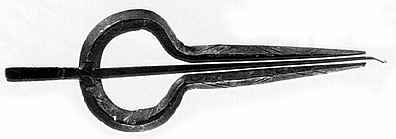

This tiny instrument is held in the left hand, the 'prongs' against the upper and lower front teeth! Some players hold the instrument between their teeth. It must make firm contact, but do not press too hard or you will give yourself toothache and potentially damage your teeth — lightly but firmly
The tongue, which protrudes from the mouth, is
made of spring steel. This is plucked with the Index finger of the right hand
(backwards, not forwards) while the tone and timbre are adjusted by changing
the shape of the mouth cavity and moving the tongue — kind of speaking
silently, effectively.
Further control of the sound can be achieved with the breath, but extensive
use of this technique for fast, staccato effect quickly results in hyperventilation;
it is better not to pass out on stage! Unusually for a percussion instrument,
you can produce a very long duration note on the morsing by sucking air through
it, sometimes (depending on the instrument) without even plucking it first.
Like the mridangam, the morsing is tuned to the tonic, which means you have
to have one for each sruti. Fine tuning is achieved by placing small amounts
of bee's wax on the end of the tongue.
Although a tiny and relatively quiet instrument, the morsing unmistakably adds to the music, reinforcing the sruti and providing a kind of textural as much as rhythmic accompaniment
When it come to the thani it is as necessary to know your lessons as it is for any of the other instruments. Be glad if you grew up speaking Tamil, or one of the worlds faster languages; it is not at all easy for a native English speaker to master konokol and, even when you have made some progress saying it it is so much harder as soon as you put the morsing to your lips!
If you are buying in India then take the opportunity to acquire as many as you can (but do test for quality first). They look as if they will last for ever, but (especially the higher srutis) they do not.